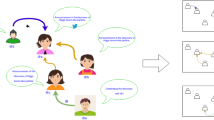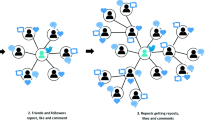Abstract
The social networks have been an important platform for people to share and exchange information in their daily life. There are some most critical users called opinion leaders who are always used to achieve the maximization of information transmission and suppress the diffusion of rumours in a short time. Many methods have been proposed by researches for these users. For identifying more accurately and efficiently, we make a further analysis for the real information spread and find that the information is commonly topic sensitive and opinion leaders are always topic limited. In the certain topic area, the users with higher authority in the topic area always play a more crucial role for the information spread. What’s more, in order to quantify the authority in certain topic area, we apply a series of rigorous definitions and topic model. Finally, comparing with the other widely used methods, the result shows the effective performance of our method.










Similar content being viewed by others
References
Ai, J., Zhao, H., Carley, K.M., Su, Z., Li, H.: Neighbor vector centrality of complex networks based on neighbors degree distribution. Phys. Condens. Matter 86(4), 1–7 (2013)
Brandes, U.: A Faster algorithm for betweenness centrality. J. Math. Sociol. 25(2), 163–177 (2004)
Gupta, B.B., Yamaguchi, S., Agrawal, D.P.: Handbook of Research on Modern Cryptographic Solutions for Computer and Cyber Security. IGI Global Publisher, Hershey (2016)
Hosseini, S., Azgomi, M.A.: A model for malware propagation in scale-free networks based on rumor spreading process. J. Comput. Netw. 108, 97–107 (2016)
Hyman, J., Li, J.: Differential susceptibility epidemic models. J. Math. Biol. 50(6), 626–644 (2015)
Krestel, R., Fankhauser, P., Nejdl, W.: Latent Dirichlet allocation for tag recommendation. In: ACM Conference on Recommender Systems (Recsys 2009), New York, NY, USA, October, pp. 61–68 (2009)
Lazarsfeld, P.E., Berelson, B., Gaudet, H.: The people’s choice. Eco-Architecture 18, 154 (1944)
Lü, L., Chen, D.B., Zhou, T.: Small world yields the most effective information spreading. New J. Phys. 13(12), 825–834 (2011). arXiv:1107.0429
Miao, Q., Meng, Y., Sun, J.: Identifying the most influential topic-sensitive opinion leaders in online review communities. In: IEEE International Conference on Cloud Computing and Big Data Analysis, pp. 330–335 (2016)
Newman, M.E.J.: A measure of betweenness centrality based on random walks. Soc. Netw. 27(1), 39–54 (2013)
Paap, J.V.R., Vissers, K., Iliffe, S., Radbruch, L., Hjermstad, M.J., Chattat, R., Vernooij-Dassen, M., Engels, Y.: Strategies to implement evidence into practice to improve palliative care: recommendations of a nominal group approach with expert opinion leaders. BMC Palliat. Care 14(1), 1–6 (2015)
Pei, S., Muchnik, L., Andrade Jr., J.S., Zheng, Z., Makse, H.A.: Searching for superspreaders of information in real-world social media. Sci. Rep. 4, 5547–5547 (2014)
Rahimkhani, K., Aleahmad, A., Rahgozar, M., Moeini, A.: A fast algorithm for finding most influential people based on the linear threshold model. Expert Syst. Appl. 42(3), 1353–1361 (2015)
Saaty, T.L.: Basic theory of the analytic hierarchy process: how to make a decision. Revista De La Real Academia De Ciencias Exactas Fsicas Y Naturales 93(4), 395–423 (1999)
Sarma, A.D., Molla, A.R., Pandurangan, G., Upfal, E.: Fast distributed pagerank computation. Theor. Comput. Sci. 561, 113–121 (2015)
Segarra, S., Ribeiro, A.: A stable betweenness centrality measure in networks. In: 2014 IEEE International Conference on Acoustics, Speech and Signal Processing (ICASSP 2014), pp. 3859–3863 (2014)
Solá, L., Romance, M., Criado, R., Flores, J., García del Amo, A., Boccaletti, S.: Eigenvector centrality of nodes in multiplex networks. Chaos 23(3), 1267–1279 (2013)
Tran, T., Lee, K.: Understanding citizen reactions and Ebola-related information propagation on social media. In: IEEE/ACM International Conference on Advances in Social Networks Analysis and Mining (ASONAM) (2016)
Wang, Z.: Sina Micro-Bolg (Online). http://weibo.com (2009). Accessed 14 Aug 2009
Wehmuth, K., Ziviani, A.: Distributed assessment of the closeness centrality ranking in complex networks. In: The Workshop on Simplifying Complex Networks for Practitioners, pp. 43–48 (2012)
Yang, L., Qiao, Y., Liu, Z., Ma, J., Li, X.: Identifying opinion leader nodes in online social networks with a new closeness evaluation algorithm. Soft Comput., pp. 1–12 (2016)
Yu, W.U., Lulu, M.A., Lin, M., Liu, H.: Discovery algorithm of opinion leaders based on user influence. J. Chin. Comput. Syst. 36(3), 561–565 (2015)
Zhang, H.: Natural Language Processing and Information Retrieval—Institute of Computing Technology (Online). http://ictclas.nlpir.org (2015). Accessed 05 Aug 2015
Zhang, L., Zhao, J., Xu, K.: Who creates trends in online social media: the crowd or opinion leaders? J. Comput. Mediat. Commun. 21(1), 1–16 (2016)
Zhang, W., He, H., Cao, B.: Identifying and evaluating the internet opinion leader community based on k-clique clustering. Neural Comput. Appl. 8(3), 595–602 (2014)
Zhang, Z., Gupta, B.B.: Social media security and trustworthiness: overview and new direction. Future Gener. Comput. Syst. (2016). doi:10.1016/j.future.2016.10.007
Zhang, Z., Sun, R., Zhao, C., Wang, J., Chang, C.K., Gupta, B.B.: Cyvod: a novel trinity multimedia social network scheme. Multimed. Tools Appl. doi:10.1007/s11042-016-4162-z (2016)
Zhou, W., Jia, W., Haghighi, M., Xiang, Y., Chen, C.: A sword with two edges: propagation studies on both positive and negative information in online social networks. IEEE Trans. Comput. 64(3), 640–653 (2015)
Acknowledgements
This study was funded by the National Natural Science Foundation of China (61671360,61672409, 61672415, 61672413, 61472310, U1135002), the National High-Tech R & D Program of China (863) (2015AA016007, 2015AA017203), the China 111 Project (B16037), the Fundamental Research Funds for the Central University (JB161505, BDZ011402).
Author information
Authors and Affiliations
Corresponding author
Ethics declarations
Conflict of interest
The authors declare that there have no conflict of interest.
Ethical approval
This article does not contain any studies with human participants or animals performed by any of the authors.
Rights and permissions
About this article
Cite this article
Yang, L., Tian, Y., Li, J. et al. Identifying opinion leaders in social networks with topic limitation. Cluster Comput 20, 2403–2413 (2017). https://doi.org/10.1007/s10586-017-0732-8
Received:
Revised:
Accepted:
Published:
Issue Date:
DOI: https://doi.org/10.1007/s10586-017-0732-8




